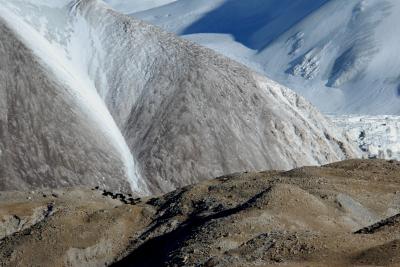In wild yak society, moms are the real climbers

These are wild yak females in their extremely rugged habitat in far western China. Credit: Wildlife Conservation Society
The authors of the study expect that this strategy is an adaptive way to avoid predators and to access more nutritious food. Wild yaks are an endangered species occurring only on the Tibetan Plateau and closely related to North American bison.
The study, which appears in the June issue of the Journal of Mammalogy is authored by Joel Berger of the Wildlife Conservation Society and the John J. Craighead professor at University of Montana; Ellen Cheng of the Ugyen Wangchuck Institute for Conservation and Environment; Aili Kang of WCS; Michael Krebs of the University of Montana; Lishu Li of Beijing; Zhao Xin Lu and Buqiong Buzhou of Kekexili National Nature Reserve Management Bureau; and George Schaller of WCS and Panthera.
The study reported that wild yak females are found on mountainous slopes averaging 15,994 feet and in groups of about 30 whereas males were more frequently in valley bottoms and groups of just two.
Wild yaks are the largest grazer north of the tropics; while weights are rarely known, they are larger than bison. Domestic yaks were once bred with bison in northern Canada in the 1920's in an attempt to make for more cold-hearty animals.
The authors of the study say that the remoteness of the wild yak's habitat gives conservationists an opportunity to study a species that has not been largely impacted by humans. Bison on the other hand, have been greatly impacted by human activity and habitat fragmentation. Their ability to range in higher elevations has been largely lost although skulls have been found in the Rocky Mountains above 12,000 feet in Utah, Colorado, and Wyoming.
Lead author Joel Berger of WCS and University of Montana said: “Neither habitat destruction nor fragmentation are issues in the yak's home in far western China, and so there are amazing opportunities to learn about why males and females respond differently to climate change and biological challenges.
But, more fundamentally, just as people climb mountains in the Himalayas because they are there, here we have a throwback to the Pleistocene; it is still here, and we by uniting people from different countries have the opportunity to conserve a species, not to mention an ecosystem and a landscape that is larger than all of Montana and Nebraska combined.”
This research was made possible through the generous support of the National Geographic Society and U.S. National Park Service.
Wildlife Conservation Society (WCS)
MISSION: WCS saves wildlife and wild places worldwide through science, conservation action, education, and inspiring people to value nature. VISION: WCS envisions a world where wildlife thrives in healthy lands and seas, valued by societies that embrace and benefit from the diversity and integrity of life on earth. To achieve our mission, WCS, based at the Bronx Zoo, harnesses the power of its Global Conservation Program in more than 60 nations and in all the world's oceans and its five wildlife parks in New York City, visited by 4 million people annually. WCS combines its expertise in the field, zoos, and aquarium to achieve its conservation mission. Visit: http://www.wcs.org; http://www.facebook.com/TheWCS; http://www.youtube.com/user/WCSMedia Follow: @thewcs.
CONTACT: STEPHEN SAUTNER: (1-718-220-3682; ssautner@wcs.org
JOHN DELANEY: (1-718-220-3275; jdelaney@wcs.org)
Media Contact
All latest news from the category: Ecology, The Environment and Conservation
This complex theme deals primarily with interactions between organisms and the environmental factors that impact them, but to a greater extent between individual inanimate environmental factors.
innovations-report offers informative reports and articles on topics such as climate protection, landscape conservation, ecological systems, wildlife and nature parks and ecosystem efficiency and balance.
Newest articles

Long-sought structure of powerful anticancer natural product
…solved by integrated approach. A collaborative effort by the research groups of Professor Haruhiko Fuwa from Chuo University and Professor Masashi Tsuda from Kochi University has culminated in the structure…

Making a difference: Efficient water harvesting from air possible
Copolymer solution uses water-loving differential to induce desorption at lower temperatures. Harvesting water from the air and decreasing humidity are crucial to realizing a more comfortable life for humanity. Water-adsorption…

In major materials breakthrough
UVA team solves a nearly 200-year-old challenge in polymers. UVA researchers defy materials science rules with molecules that release stored length to decouple stiffness and stretchability. Researchers at the University…



